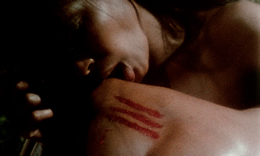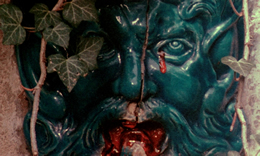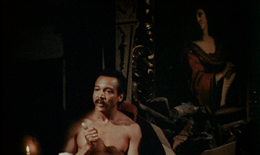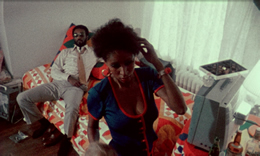
Color, 1973, 109m.
Directed by Bill Gunn
Starring Duane Jones, Marlene Clark
Kino (Blu-Ray) / (US R0 HD) / WS (1.66:1) (16:9),
AllDay (US R1 NTSC) / WS (1.85) (16:9)

Color, 1973, 109m.
Directed by Bill Gunn
Starring Duane Jones, Marlene Clark
Kino (Blu-Ray) / (US R0 HD) / WS (1.66:1) (16:9),
AllDay (US R1 NTSC) / WS (1.85) (16:9)
 Often cited as the thinking person's black horror film, this became something of a legend to collectors in the '80s and '90s who heard about it but never actually saw it except in awful, blurry bootleg tapes. Video Watchdog devoted one of its earliest issues to the saga of Gunn's lost classic, and a heavily edited (by over 30 minutes) version called Blood Couple circulated on video and haunting the shelves of Blockbuster under a wide variety of titles (Black Vampire, etc.). Apart from unwatchable bootleg tapes, no one really had a chance to see the full length
Often cited as the thinking person's black horror film, this became something of a legend to collectors in the '80s and '90s who heard about it but never actually saw it except in awful, blurry bootleg tapes. Video Watchdog devoted one of its earliest issues to the saga of Gunn's lost classic, and a heavily edited (by over 30 minutes) version called Blood Couple circulated on video and haunting the shelves of Blockbuster under a wide variety of titles (Black Vampire, etc.). Apart from unwatchable bootleg tapes, no one really had a chance to see the full length director's cut until AllDay's DVD release, which came out in two versions (one flat, the second 16x9), followed in 2012 by a Blu-Ray and DVD reissue from Kino.
director's cut until AllDay's DVD release, which came out in two versions (one flat, the second 16x9), followed in 2012 by a Blu-Ray and DVD reissue from Kino.
Much closer to Dreyer's Vampyr than Blacula in its elliptical storytelling methods and deliberate pace, Ganja and Hess is bound to disappoint fans of fang-chomping and gore. Gunn's film is a challenging, rich, and invigorating effort, crammed with ruminations on the conflict between African and modern Christian American culture, the suppression of instinct through will, and blood as a lifeforce and sustainer of heritage. Duane Jones (best known as Ben in the immortal Night of the Living Dead) makes for a great iconic hero (of sorts), and the gorgeous Marlene Clark matches him scene for scene. The plot, such as it is, involves a noted anthropology professor (Gunn himself) who is stabbed with a knife from the mystical culture of Myrthia. He finds himself unable to age and addicted to blood, an affliction he passes on to Jones before killing himself. Gunn's wife, Ganja (Clark), arrives and becomes involved in a dark, passionate relationship with Jones, leading to unexpected consequences.
 Though the film is fairly strong (it contains a good deal of blood and what must be, at the time, a record amount of frontal male nudity for the genre including the director himself), the overall tone is meditative and subdued, leaving a subliminal chill that lingers on the back of your neck long after the film is over. AllDay did a stunning job with the transfer, revealing astonishing detail and colour sensitivity which immeasurably add to the impact of Gunn's achievement. The running feature commentary by Clark and several of the crew members affirms that this film was made with a great deal of energy, verve, and shoestring survival tactics. Also included are some promotional materials, including a number of really odd ultra-'70's cast photos.
Though the film is fairly strong (it contains a good deal of blood and what must be, at the time, a record amount of frontal male nudity for the genre including the director himself), the overall tone is meditative and subdued, leaving a subliminal chill that lingers on the back of your neck long after the film is over. AllDay did a stunning job with the transfer, revealing astonishing detail and colour sensitivity which immeasurably add to the impact of Gunn's achievement. The running feature commentary by Clark and several of the crew members affirms that this film was made with a great deal of energy, verve, and shoestring survival tactics. Also included are some promotional materials, including a number of really odd ultra-'70's cast photos.

The Kino Blu-Ray, mastered from the negative created by the Museum of Modern Art from the only usable 35mm elements of Gunn's original cut, will probably annoy anyone unfamiliar with the film's history; it's still very grainy and cheap-looking, of course, but it looks very filmic and jumps ahead of its predecessors in the clarity department. Crucially, it's also correctly framed at 1.66:1. Don't expect visual wonders here, but thank God they didn't try to noise reduce this into oblivion. Along with the gallery, the "Thirst for Blood" documentary (29 minutes) created for the second DVD release is included, featuring producer Chiz Schultz and excerpts from a pre-screening chat about the film with an audience, covers the history of the film's creation, its addiction themes, and its bizarre distribution history.
As a side note, it's unfortunate that no releases to date on DVD or Blu have included the alternate, shorter Blood Couple print for comparison, as this "butchered" version does contain some footage that was scrapped from the original cut and merits some side-by-side study. In any case, this is an essential purchase for film scholars and horror fans interested in seeing what the fuss is all about, as long as you're willing to set aside the slice and dice expectations ingrained by modern slasher films.
![]()